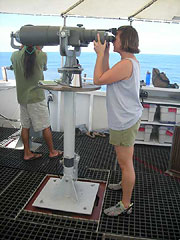Journals 2007/2008
Heather Judkins
Seminole High School, Seminole, FL
November 14, 2007
New Role on Board
I started my new job while onboard today! There are 4 visiting scientists and we are rotating through the various project positions. I am officially done with the oceanography end of things and onto marine mammal and bird observations. I am an independent observer on closing mode days (today is one) which means that when the mammal observers spot a school of animals and close in on them, the independent observer is scanning the rest of the area for other possible schools. There are always two observers on the "big eyes" while one observer is recording any data that comes in about the schools. There is also a bird expert identifying and recording any bird species each day.
The "big eyes" are a large pair of binoculars which one can see up to 7 miles away. One pair of these costs approximately $20,000.00! There are 4 pairs of big eyes on the fly bridge. When I look through them, I can see the horizon and waves coming over it. Today I could see the smoke stacks of a container ship before I saw the ship. It was 16 miles away at that point! Pretty cool.

Scientist Profile:
Michael Force, Senior Seabird Observer
For this cruise, Michael is the senior seabird observer. He was born in British Columbia and has been fascinated by birds since he was seven years old. He first did some forest bird survey work before hitting the oceans in 1974. In 1988, he started going out to sea for extended time and has been in all oceans of the world. He is chosen for various surveys year round that are conducted worldwide and is asked back not only to remain consistent in data collection but for his expertise as well! He has 3000 days at sea since 1990! That is quite a feat!
Why does he do it? His love for birds. He is one of the fortunate people that had a hobby that he turned into a fulfilling career. The most rewarding aspect of his job is seeing birds that others only dream about. For example, he is a part of an Antarctic Survey which monitors bird populations which many people will never experience. The challenging aspect of his position is having a bad day at sea. What makes a day at sea bad? No birds!
When asked about his favorite seabirds... The Snow Petrel is a bird that is found in the Southern Ocean and is the only petrel which is totally white. It is an ice bird and nests on rocky cliffs in Antarctica.
His words to live by? "Follow your passion!"
Marine Science Questions:
1. What color are most petrels in the world?
2. Using the NOAA ship tracker, what is my position today? (lat/long)
|




